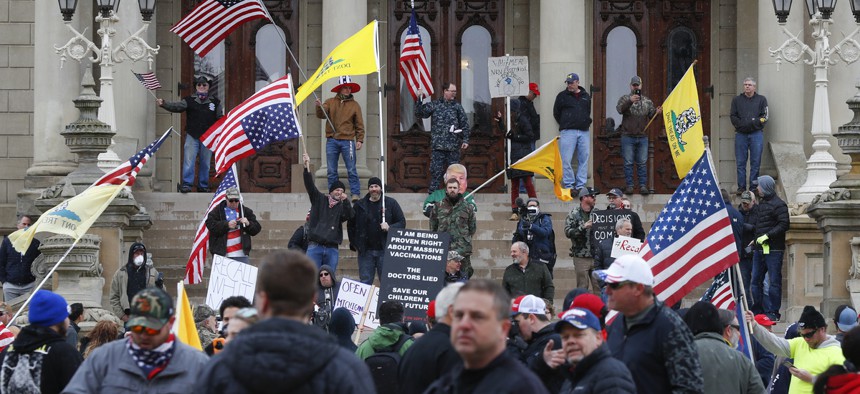Protests Erupt at State Capitols Over Stay At Home Orders

Protesters at the Michigan State Capitol in Lansing. AP Photo/Paul Sancya

Connecting state and local government leaders
In several states, protesters are fighting back against stay-at-home orders designed to slow the spread of coronavirus.
Opponents of the stay-at-home orders most states have put in place in response to the coronavirus pandemic found their way to state capitols this week, with organized demonstrations against the restrictions and the governors who imposed them popping up in several states.
Most governors have implemented the stay-at-home orders in the past few weeks in an effort to slow the spread of the highly contagious virus and to help prevent hospital systems from being overwhelmed by patients ill with Covid-19, the respiratory disease that the virus causes. While one survey found that 81% of Americans support a national stay-at-home order, some people are unhappy with the measures and say that they hurt the economy and infringe on personal liberties.
Michigan, Ohio, North Carolina, and Kentucky are among the states that saw protests early this week, and future protests are planned for the coming days in Texas and Oregon.
Demonstrators are waving signs with messages like "liberty once lost is lost forever” and “we will not comply” to assert their displeasure with the public health directives that officials say have been critical to "flattening the curve" of the outbreak.
In Michigan, several thousand protesters arrived in cars, honking their horns and surrounding the state capitol. About 100 of them stood on the lawn and steps of the capitol building, many of them holding signs calling for the recall of Gov. Gretchen Whitmer, a first term Democrat. The protest was organized by conservative groups and featured chants like “lock her up.” A reporter for Michigan Live described it as “half protest, half Trump rally.” Meshawn Maddock, a leader of the Michigan Conservative Coalition, said on Facebook Live that she hopes the protest will convince Whitmer to roll back emergency coronavirus policies. “There’s no reason why right now today she couldn’t come out and say, ‘Michigan, I hear you, and it’s time to get workers back to working,’” Maddock said.
Whitmer said that while she understands the anger over business closures and travel restrictions, she was disappointed that protesters congregated without masks and caused an ambulance to get stuck in traffic. “I know that people are angry, and that’s okay, and if you want to take it out and send it my way … I urge you don’t put yourself at risk and don’t put others at risk either,” she said at a press briefing after the protest. "We know that this demonstration is going to come at a cost to people's health. The sad irony of the protest is that they don't like to be in this stay-at-home order, but they might have just created a need to lengthen it."
Kentucky Gov. Andy Beshear, also a first term Democrat, faced similar demonstrations from protesters this week. Protesters chanted for an hour in the background of Beshear’s press briefing on Wednesday, using the calls “we want to work” and “re-open Kentucky.” Beshear acknowledged the discontent in the middle of the briefing. “We do have some folks up in here in Kentucky today—and everybody should be able to express their opinion—that believe we should reopen Kentucky immediately, right now," he said. "Folks, that would kill people. That would absolutely kill people … There is not partisanship in this. I'm just us doing what it takes to protect people.”
President Trump has been pushing a May 1 end date for lockdowns in certain parts of the country, a plan that most public health experts—including Dr. Anthony Fauci, the federal government’s top infectious disease expert—say is “overly optimistic.” Health officials caution that without widespread testing and contact tracing procedures, asymptomatic carriers could continue to spread the virus and lead to a second wave of cases after social distancing measures are relaxed.
In the absence of a clear national plan, over a dozen governors have formed regional alliances to coordinate as they begin to think about easing restrictions. Beshear announced at the same briefing that he was working with the governors of Ohio and Indiana on an effort to reopen the states when data on the reduced spread of the virus indicates such measures would be safe.
In Ohio, Gov. Mike DeWine is facing pressure from his own party. DeWine, a Republican, has been lauded for his early leadership in implementing statewide social-distancing measures and the impact his decisions had on flattening the curve in the state. Now, conservative state legislators say that enough work has been done and the state should reopen shuttered businesses to boost the economy. “We can’t stay like this much longer,” state Sen. Andrew Brenner, a Republican, wrote on Facebook. “The hundreds of thousands of Ohioans who’ve lost their jobs or the thousands of small business owners can’t keep doing this either, or their lives will be irreparably destroyed.”
Protesters appeared at the Ohio state capitol last week, as well as on Monday and Tuesday, carrying signs with similar messages. “Open Ohio: We want our rights back," one reads. DeWine responded to protesters by saying that “this isn’t some kind of game” he’s playing. “This isn’t something where I woke up one day and decided I’m going to impose these regulations on the state,” he said. “Ohioans have done well … Ohioans have changed the outcome … But no one should think this thing is over.”

NEXT STORY: Concerts and Sporting Events Could Be Canceled Until 2021, Mayors Say





